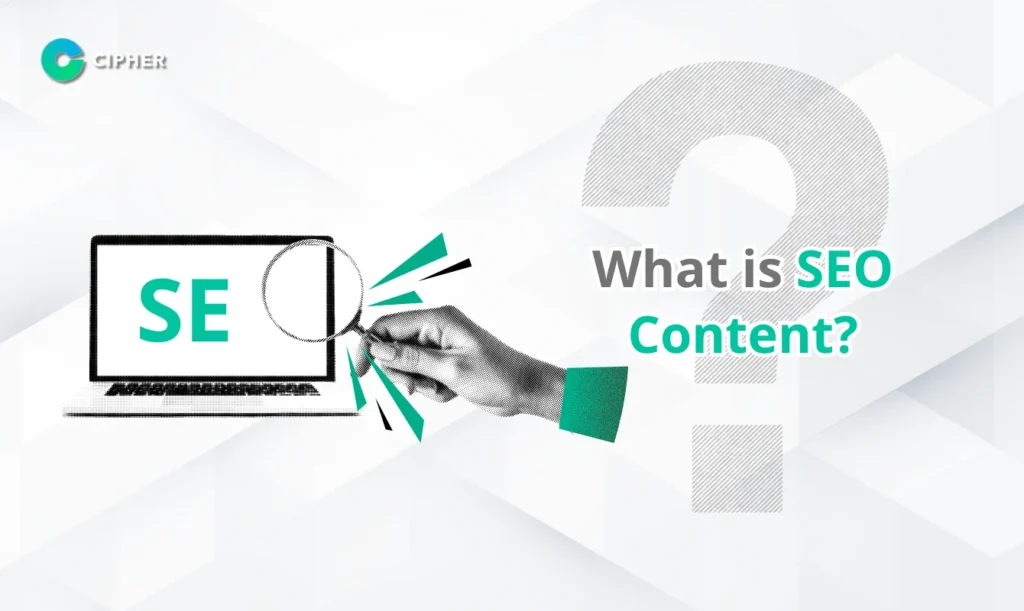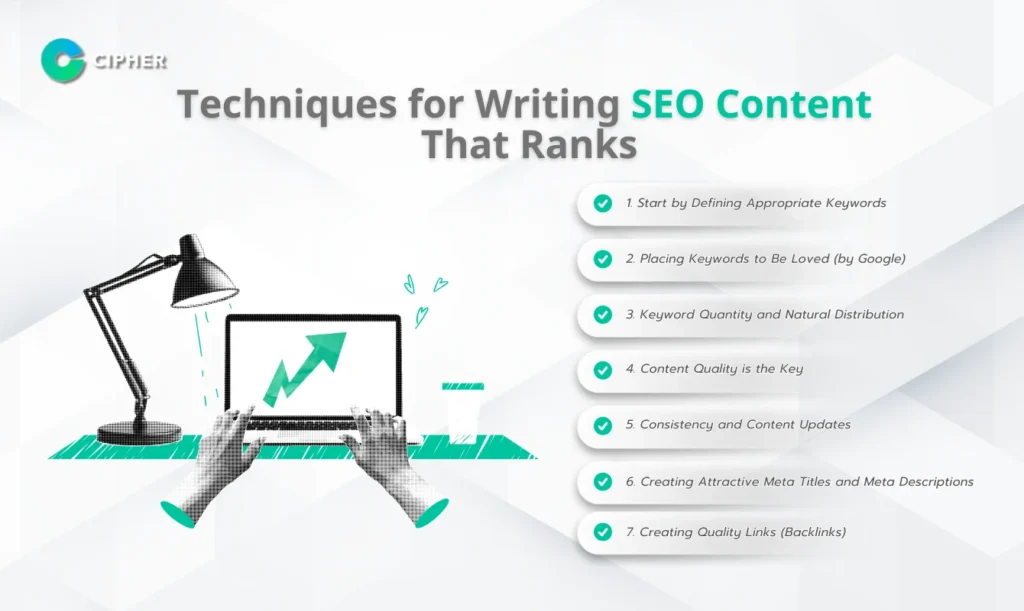In today’s digital landscape, simply creating a website is no longer enough. If no one can find your site, it’s like opening a store with no customers walking in. Search Engine Optimization (SEO) content is one of the key digital marketing strategies that will help your website rank in search results and reach your target audience effectively. Mastering SEO content writing is essential for increasing organic traffic and improving your website’s visibility online.
Table of Contents
What is SEO Content?

SEO Content refers to creating articles or content specifically designed to attract readers while being friendly to Google’s algorithm, helping your website rank on the first pages of search results.
Quality SEO content must address the search intent of users, provide reliable information, and offer value, which will help increase organic traffic to your website more easily. SEO content optimization involves various techniques that work together to improve your website’s visibility in search engine rankings.
While many might think SEO writing is just about stuffing keywords, the reality is that there are many factors to consider in creating effective SEO content. In fact, excessive keyword insertion can actually harm your SEO efforts and website quality. Modern search engines prioritize user-focused content that delivers genuine value.
The Importance of SEO Content
SEO content writing remains highly important today, even as consumer behavior shifts toward social media. Searching for information through search engines continues to be an essential tool for people solving various problems, and optimizing your content for search engines can significantly improve your website’s performance.
The benefits of creating SEO content are numerous:
- Build brand credibility – Marketing solely through social media channels may not be sufficient to establish brand credibility. Having a website with quality content helps build brand awareness and demonstrates expertise in your products, making customers more likely to choose your brand over competitors. A well-optimized website with valuable content establishes your brand as an authority in your industry.
- Reach your target audience directly – SEO writing attracts your target audience by creating content that meets consumer needs, using appropriate keywords naturally distributed throughout the article to provide maximum benefit to readers. With the right SEO content strategy, you can connect with users who are actively searching for information related to your business.
- Cost-effective in the long run – SEO content creation is a form of online marketing that requires minimal budget compared to the number of website visitors from organic search. When done consistently, it increases the chances of your website appearing on the first page of search results, boosting sales opportunities and generating long-term revenue. Unlike paid advertising, organic traffic through SEO continues to deliver results without ongoing costs.
- Elevate website quality – People often search Google when they have problems or want information. If your target customers find articles from your website that answer their questions or provide useful information, it not only creates brand awareness but also builds credibility and increases the chance of converting them into customers. Search engines like Google reward websites with high-quality, relevant content by improving their search rankings.
Types of Interesting SEO Content
There are various formats of SEO content that you can choose to suit your business and improve your search engine rankings:
- Informational articles – Articles that provide in-depth information, interviews, or updates related to your business. These help establish your website as an authoritative resource in your industry.
- List content – Content divided into clear subtopics, such as “5 Ways to Write SEO Content That Ranks,” making it easy to read and quickly understand. List-based content tends to perform well in search results and has higher click-through rates.
- How-to guides – Step-by-step content that provides instructions, such as “SEO Writing Guide for Beginners.” These comprehensive guides target users with specific questions and increase time spent on your website.
- Videos – Content in video format that explains or demonstrates products/services, which can be optimized to rank on both YouTube and Google. Video content can significantly boost engagement metrics and dwell time.
- Infographics – Presenting information in graphic format, helping explain complex data in an easily understandable way with high sharing potential. Infographics can attract backlinks and improve social signals.
- Slideshows – Presenting content in slide format, also known as Carousel Content, making content more interesting and interactive for users.
- Glossaries – Collections of specialized terms or technical vocabulary related to your industry. These can capture search traffic from users looking for specific definitions.
- Directories – Collections of information about products and services, along with contact channels that appear on search engines. These help organize content and improve user navigation on your website.
Techniques for Writing SEO Content That Ranks

1. Start by Defining Appropriate Keywords
Every article needs keywords or important terms that you want people to find when they search. When writing SEO content, you should start by thinking about your target audience and what keywords they might use to search for your topic. Effective keyword research is the foundation of successful SEO content.
Methods for choosing good keywords for SEO writing:
- Write about what you want to present – Start simply with what you want to write about; that topic is your keyword. For example, if you’re writing about “building a website with WordPress,” your keywords might be “building a website” or “WordPress.” Focus on topics relevant to your business and expertise.
- Think from the user’s perspective – Beyond finding keywords from your own perspective, try thinking about what potential searchers actually want. For example, if you’re writing about building a website with WordPress, people might search for “DIY website,” “how to create a website,” or “how to use WordPress.” Understanding search intent is crucial for content optimization.
- Use keyword research tools – If you want to choose keywords that actually help improve your website ranking and have real search volume, using keyword research tools like Google Keyword Planner, Ubersuggest, or Keysearch will be very helpful. These tools show the search volume for keywords and assess how difficult it is to compete for those keywords. Look for long-tail keywords with moderate competition that align with your content goals.
2. Placing Keywords to Be Loved (by Google)
Once you know your keywords, the next step is understanding the technique of inserting keywords to make your content easy to find. Google assigns different importance to different parts of your content. Strategic keyword placement is essential for effective on-page SEO. Important places to include keywords in SEO article writing:
- Title or article name – The article title is the first place where the main keyword should appear to tell Google what this article is about. Your title tag should be compelling, relevant, and contain your primary keyword preferably near the beginning.
- Article URL – If your keyword is in English, you can include it directly in the URL. If it’s in another language, you may need to choose between not including it or using it anyway (which might make the URL less attractive when shared). A clean, descriptive URL structure helps both users and search engines understand your content.
- Description or article summary – By default, this refers to the first paragraph, but you can customize the description. For example, if using WordPress, you can use Yoast SEO to edit it. Your meta description should contain your primary keyword and entice users to click through from search results.
- Headings or various subheadings – Include keywords in the article’s subheadings (H2, H3) to help Google understand the content structure and help improve website quality. A clear heading hierarchy improves readability and helps search engines identify the main topics of your content.
- Image names and Alt Text – Many people may not know that image names also affect SEO. Before uploading, name images with keywords, and after uploading, include keywords in the Alt Text. Properly optimized images can appear in image search results, bringing additional traffic to your website.
3. Keyword Quantity and Natural Distribution
Keywords aren’t just inserted at strategic points but should also appear naturally throughout the article body. However, you shouldn’t include too many, as Google will identify this as keyword stuffing. Keyword density should not exceed 2.5% of the total content. Natural keyword usage creates a better user experience while satisfying search algorithms.
Recommendations for SEO writing:
- Include keywords in the first sentence of the article to establish relevance immediately
- Distribute keywords naturally throughout the article without forcing them where they don’t fit
- In WordPress, use SEO plugins like Yoast SEO to check keyword density and get suggestions for improvement
4. Content Quality is the Key
World-class search engines want search results that please users. This means the system must present quality content. Google’s algorithms have evolved to prioritize high-quality, valuable content over keyword-optimized but thin content. Factors indicating quality SEO content:
- Article length – Longer articles tend to be of higher quality. Many experts recommend content of at least 1,000 words to improve website quality. Comprehensive content that covers a topic thoroughly tends to rank better in search results.
- Fresh content (Original Content) – “Fresh” has two meanings: written by you, not duplicated (not copied or rewritten from other articles), and written before others. Original content that provides unique insights or perspectives is valued by both users and search engines.
- Social Media Engagement – Particularly when an article receives many shares, it will have a significant impact on SEO. If the article is truly useful or impresses readers, they will be motivated to share it. Social signals can indirectly influence your search rankings by increasing visibility and driving more traffic to your site.
5. Consistency and Content Updates
Well-written and SEO-optimized articles may not show immediate results because it takes time for a website to grow, gain high authority, and be recognized by Google. In Google’s view, consistently published content shows that the website is well-maintained, growing, and continuously visited. Content freshness is a significant ranking factor.
For branding, websites with continuous content help brands interact with and maintain relationships with readers. If there’s a plan to create content in specific areas, the brand will gain credibility and appear as an expert in those topics. Implementing a consistent content calendar helps maintain regular publishing schedules.
Additionally, after publishing content, you need to check your website ranking, analyze competitor websites, and update content to make it better. In Google’s eyes, new or updated content is more credible because it’s seen as having the most current information. Regular content audits and updates are essential for maintaining and improving your search rankings.
6. Creating Attractive Meta Titles and Meta Descriptions
Meta Tags are code that Google’s crawlers collect. The important components for SEO writing are Meta Title and Meta Description, which should be written in an engaging way to attract users to click and read, and must include the Primary Keyword in the Meta Title. These elements significantly impact your click-through rate from search results.
For Meta Description, besides the Primary Keyword, you can also add Secondary Keywords. A well-crafted meta description acts as an organic advertisement for your content in search results, enticing users to click through to your website.
If you don’t include these two parts, Google will pull information from the content itself, which may not include the main keywords or be interesting. Some websites may set the same Meta Title and Meta Description for every page, which is not good for SEO and website quality. Each page should have unique, relevant meta information that accurately describes its content.
7. Creating Quality Links (Backlinks)
Backlinks are necessary for highly competitive keywords, especially in businesses where competitors do a lot of link building. However, you should study this well first, because if you create low-quality links, Google will view your website as low quality, and your previous SEO content efforts may be wasted. Off-page SEO is as important as on-page content optimization.
Backlinks are links to your website placed on other websites or platforms. They are an important factor in SEO. Having many backlinks increases the likelihood that Google will assign a higher score to the destination link page. However, you should consider the quality of backlinks, which should be from websites with content related to your business, and the links must be functional, not spam. Focus on earning natural, relevant backlinks rather than artificial link building.
Additionally, if the content of articles on your web pages is interrelated, you can include internal links for readers to click for more information, increasing website traffic and keeping visitors on your site longer. A strong internal linking strategy improves site navigation, distributes page authority, and helps search engines better understand your website structure.
How to Check SEO Content Effectiveness
1. SEO Technical Aspects
- Keyword Rankings – Shows where your website’s content appears in Google search results based on keyword rankings. Track your positions for target keywords to measure your SEO progress over time.
- Organic Traffic – The number of visitors who come to your website from organic search results. Increasing organic traffic is often a primary goal of SEO content strategies.
- Click-Through Rate (CTR) – The percentage of people who click on your content when it appears in Google search results. A higher CTR indicates that your meta titles and descriptions are effective.
- Backlinks – The number of other websites that include reference links to your website or content. Monitor both the quantity and quality of backlinks to understand your content’s authority.
2. Website Engagement
- Channel Groups – Helps analyze which channels searchers used to find your content. Understanding traffic sources helps refine your content distribution strategy.
- New Visitors – The number of new users or people visiting your website for the first time through your content. This metric helps measure your content’s reach.
- Bounce Rate – The percentage of visitors who navigate away from your site after viewing only one page. A lower bounce rate generally indicates more engaging content.
- Value-Conversion – Helps determine if visitors value the content enough to convert. Tracking how content contributes to conversions helps measure its business impact.
3. Social Media
- Reach – Indicates how many people your content reaches across social platforms. Broader reach can amplify your content’s impact beyond search.
- Engagement – Searcher engagement with that content, such as sharing to other channels or platforms. High engagement signals that your content resonates with your audience.
4. Brand Building
- Impressions – The number of times your content is displayed in search results, whether or not users click through. More impressions increase brand awareness.
- Share of Voice – Content effectiveness compared to similar content websites in your industry. This competitive metric helps gauge your market position.
- Brand vs Non-Brand Search Traffic – Comparing search volumes between branded and non-branded content. Growing branded search traffic indicates increasing brand recognition.
5. Sales Generation
- Lead Quality – The number of leads from people interested in registering or signing up through the website. Quality SEO content should generate qualified leads.
- Conversion – The number of orders or sales generated on the Landing Page and Page Value. Ultimately, content should contribute to business goals.
Creating Personas to Enhance SEO Content Effectiveness
What is a Persona?
How to Create Personas for SEO Content
- Gather target audience data – Analyze from customer databases, surveys, interviews, and Google Analytics data
- Define basic information – Name, age, gender, occupation, income, education, marital status
- Identify online behavior – Platforms used, search behaviors, commonly used keywords, devices used to access websites
- Discover challenges and problems – Obstacles or unmet needs
- Specify goals – What the target audience wants to achieve
Benefits of Personas for SEO Content
- Target-appropriate keyword selection – Understanding what terms customers use in searches
- Adjust writing tone – Choose communication styles suitable for the target audience
- Create responsive content – Address problems the target audience is facing
- Design appropriate UX/UI – Arrange website elements to match usage behaviors
- Increase engagement rates – Readers feel the content was written specifically for them
Examples of Applying Personas in SEO Content Writing
Once you have clear personas, you can customize SEO content by:
- Using keywords that match your persona’s search terms
- Adjusting content formats to suit how your persona consumes information (long articles, infographics, videos)
- Designing CTAs that respond to your persona’s goals
- Creating content that solves specific problems your persona is experiencing
Implementing personas will help make your SEO content not only search engine friendly but also truly reader-friendly for your target audience. This will result in higher engagement rates, lower bounce rates, and increased chances of conversion.
Quality SEO Content Production Services to Elevate Your Website
Professional SEO services understand that writing effective SEO articles requires expertise and appropriate strategies. A comprehensive SEO service should be ready to help your business rank in search results with services including:
- SEO Strategy Analysis and Planning – Starting with business analysis, competitors, and target audience behavior to plan an SEO Content strategy suitable for your business. A data-driven approach ensures that your content efforts align with market opportunities.
- High-Quality SEO Content Production – Professional writing teams create SEO articles that not only include keywords but also provide valuable information that appeals to your target audience. Content should be engaging, informative, and optimized for both users and search engines.
- On-page SEO Optimization – Optimize all elements on your website to be search engine friendly, including Meta Tags, URL Structure, Heading Tags, and more to increase website quality. Technical SEO ensures that search engines can properly crawl and index your content.
- Quality Backlink Creation – Develop strategies for creating backlinks from reputable websites to increase your website’s authority. Off-page SEO complements your content efforts by building your site’s reputation across the web.
- Monitoring and Reporting Results – Continuously measure and analyze SEO Content performance, adjusting strategies for better results. Regular reporting helps track progress and identify opportunities for improvement.
With experience in digital marketing, professional SEO services can elevate your business’s SEO content to stand out above competitors. An effective SEO partner should provide comprehensive support from keyword research to content creation and ongoing optimization.
Summary
SEO writing is an art that combines both technique and reader understanding, focusing on creating quality content that provides value, naturally incorporates keywords, and is done consistently. It’s not just about stuffing keywords or focusing on any single factor. Core Web Vitals and user experience metrics are becoming increasingly important ranking factors alongside traditional SEO elements. Properly investing in SEO Content will create valuable long-term returns, helping your website accurately reach target audiences without paying for advertising. Search engines continuously evolve their algorithms, but quality content remains at the heart of successful SEO. Start today to create sustainability for your business in the online world!
Frequently Asked Questions
What is SEO Content?
How do you write SEO articles?
SEO Article Writing Principles:
- Include appropriate keywords in every article, especially in main and sub-headings to improve content structure and searchability
- Write easy-to-understand URLs with main keywords appearing to help both readers and Google immediately understand that page’s content
- Distribute keywords naturally throughout the article, not forcing too many, as this will make readers uncomfortable and may trigger search engine penalties
- Prioritize writing Heading Tags or various topics in the correct hierarchical order to help Google understand the content structure
- Include image names and Alt Text related to the content to help your images appear in image searches
- Focus on writing quality content that meets reader needs as Google requires, prioritizing user experience over keyword optimization
Focus on writing quality content that meets reader needs as Google requires, prioritizing user experience over keyword optimization
SEO focuses on creating quality content and improving websites to better climb search rankings organically, which takes time but produces sustainable results. It’s a long-term strategy that involves optimizing your website structure, content, and earning quality backlinks.
SEM focuses on paying to make desired web pages appear immediately on the first page or in good rankings in search results, but when you stop paying, the ranking disappears. This includes services like Google Ads and other paid search marketing.
Therefore, businesses that need quick results should use SEM alongside SEO for long-term sustainability. An effective digital marketing strategy typically combines both approaches, using SEM for immediate visibility while building SEO for lasting organic traffic.





